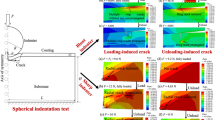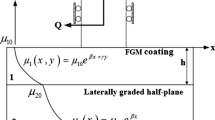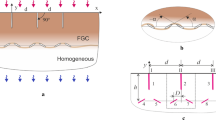Abstract
A typical application of functionally graded materials (FGMs) is the coating of homogeneous or inhomogeneous substrates. This work investigates numerically an interfacial crack between an FGM coating and a rigid substrate that is subjected to shear–compression loading under the effect of friction. Two types of linearly graded coatings and one homogeneous coating exhibiting the same average Young’s modulus were examined. Two different numerical methods were applied for solving the singular receding contact problem: in-house finite difference software and a commercial finite element software. The effect of friction on the crack closure parameters such as tangential shifts and normal gaps of the crack face were studied with both methods and revealed an excellent agreement between the two. The effect of friction on the transition of the crack face from the slip to stick condition was studied as well. An extended J line formulation was used to extract the stress intensity factors (SIFs) for the crack tip for which the adjacent crack face experiences a large frictional contact. It was demonstrated that increasing the coefficient of friction causes a decrease in the tangential shifts and normal gaps until the whole crack face exhibits stick. The linear gradation in which the material is harder on the interface than on the top results in lower crack face displacement and SIFs.











Similar content being viewed by others
References
Chen YF, Erdogan F (1996) The interface crack problem for a nonhomogeneous coating bonded to a homogeneous substrate. J Mech Phys Solids 44(5):771–787
Chen Y, Erdogan F (1992) “The interface crack problem in nonhomogeneous bonded materials of finite thickness”. Final project report. Lehigh University Bethlehem PA. Accession Number : ADA256990. Aug
Choi HJ, Paulino GH (2010) Interfacial cracking in a graded coating/substrate system loaded by a frictional sliding flat punch. Proc R Soc A Math Phys Eng Sci 466(2115):853–880
Comninou M (1977) Interface crack with friction in the contact zone. J Appl Mech 44(4):780
Comninou M (1979) On the frictional contact in crack analysis. Eng Fract Mech 12(1):117–123
Delale F, Erdogan F (1988) Interface crack in a nonhomogeneous elastic medium. Int J Eng Sci 26(6):559–568
Dorogoy A (2018) Finite difference method for solving crack problems in a functionally graded material. Simul Trans Soc Model Simul Int. https://doi.org/10.1177/0037549718802894
Dorogoy A, Banks-Sills L (2004) Shear loaded interface crack under the influence of friction: a finite difference solution. Int J Numer Methods Eng 59(13):1749–1780
Dorogoy A, Banks-Sills L (2005) Effect of crack face contact and friction on Brazilian disk specimens—a finite difference solution. Eng Fract Mech 72(18):2758–2773
Dorogoy A, Banks-Sills L (2008) “A rigid punch on an elastic half-space under the effect of friction: a finite difference solution. In: Volume 2: automotive systems; bioengineering and biomedical technology; computational mechanics; controls; dynamical systems, pp 259–271
Dundurs J, Comninou M (1979) Some consequences of the inequality conditions in contact and crack problems. J Elast 9(1):71–82
Dundurs J, Stippes M (1970) Role of elastic constants in certain contact problems. J Appl Mech 37(4):965
Eischen JW (1987) Fracture of nonhomogeneous materials. Int J Fract 34(1):3–22
Erdogan F (1995) Fracture mechanics of functionally graded materials. Compos Eng 5(7):753–770
Gautesen AK (1993) The interface crack under combined loading: an eigenvalue problem for the gap. Int J Fract 60(4):349–361
Gu P, Asaro RJ (1997) Crack deflection in functionally graded materials. Int J Solids Struct 34(24):3085–3098
Guo L, Huang S, Zhang L, Jia P (2018) The interface crack problem for a functionally graded coating-substrate structure with general coating properties. Int J Solids Struct 146:136–153
Jha DK, Kant T, Singh RK (2013) A critical review of recent research on functionally graded plates. Compos Struct 96:833–849
Jin ZH, Batra RC (1996) Some basic fracture mechanics concepts in functionally graded materials. J Mech Phys Solids 44(8):1221–1235
Jin Z-H, Noda N (1994) Crack-tip singular fields in nonhomogeneous materials. J Appl Mech 61(3):738
Keer LM, Dundurs J, Tsai KC (1972) Problems involving a receding contact between a Layer and a half space. J Appl Mech 39(4):1115
Ozturk M, Erdogan F (2008) On the singularities in fracture and contact mechanics. J Appl Mech 75(5):051111
Petrova V, Schmauder S (2015) Crack closure effects in thermal fracture of functionally graded/homogeneous bimaterials with systems of cracks. ZAMM—J Appl Math Mech / Zeitschrift für Angew Math und Mech 95(10):1027–1036
Rice JR (1968) A path independent integral and the approximate analysis of strain concentration by notches and cracks. J Appl Mech 35(2):379
Rice JR (1988) Elastic fracture mechanics concepts for interfacial cracks. J Appl Mech 55(1):98
Schulz U, Peters M, Bach F-W, Tegeder G (2003) Graded coatings for thermal, wear and corrosion barriers. Mater Sci Eng A 362(1–2):61–80
Shbeeb NI, Binienda WK (1999) Analysis of an interface crack for a functionally graded strip sandwiched between two homogeneous layers of finite thickness. Eng Fract Mech 64(6):693–720
Simulia, “Abaqus/CAE version 6.14-2 (2014). Dassault Systèmes Simulia Corp., Providence, RI, USA.” (2014)
Simulia, “Abaqus/Explicit Version 6.14-2, Abaqus documentation . Dassault systemes, 2014.” (2014)
Acknowledgements
The assistance and support of Professor Daniel Rittel is greatly appreciated.
Author information
Authors and Affiliations
Corresponding author
Additional information
Publisher's Note
Springer Nature remains neutral with regard to jurisdictional claims in published maps and institutional affiliations.
Appendix A
Appendix A
The UMAT subroutine was used with Abaqus for material model of \(\alpha = -4/3\).

Rights and permissions
About this article
Cite this article
Dorogoy, A. Shear–compression loaded interface crack between a rigid substrate and an FGM layer—frictional crack closure effects. Int J Fract 216, 149–159 (2019). https://doi.org/10.1007/s10704-019-00348-y
Received:
Accepted:
Published:
Issue Date:
DOI: https://doi.org/10.1007/s10704-019-00348-y




